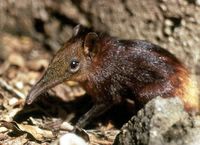From the University of Florida press release:
A University of Florida scientist has found the first evidence for origins in North America of a mammal thought to be endemic to Africa. Long considered the cradle of many mammal species, Africa no longer lives up to that image with the discovery in the Wyoming badlands of 54 million-year-old skeletal remains of the first elephant shrew, said Jonathan Bloch, a UF paleontologist who describes his team’s finding in today’s issue of the journal Nature.
 “Elephant shrews – part of a group that includes elephants, sea cows and aardvarks, are thought to be endemic to Africa – yet we have found evidence of their beginnings in North America,” Bloch said. “This research has broad implications because it indicates there may have been a great deal more interchange in terms of how animals moved around the world as the continents broke up than previously thought.”
“Elephant shrews – part of a group that includes elephants, sea cows and aardvarks, are thought to be endemic to Africa – yet we have found evidence of their beginnings in North America,” Bloch said. “This research has broad implications because it indicates there may have been a great deal more interchange in terms of how animals moved around the world as the continents broke up than previously thought.” “It is at least possible that primates, like primitive elephant shrews, evolved in North America and spread from there into Europe, Asia and Africa,” said Bloch, who works at the Florida Museum of Natural History on the UF campus. The first modern mammals appeared about 55 million years ago, roughly 10 million years after the mass extinction of the dinosaurs that had dominated them. In this Eocene period arose the first modern primates, the first recognizable horses and many other mammals, Bloch said.
“After the extinction of the dinosaurs 65 million years ago, there was an explosion of diversity,” he said. “Mammals had a huge celebration with all the big predators gone and they just kind of took over. They went crazy, filling all the open ecological niches they couldn’t have exploited while the dinosaurs were still around.”
About 55 million years ago, a dramatic short-term global warming event took place. It lasted 100,000 years at the most, but it brought about the emergence of a huge assortment of new creatures all over the globe, Bloch said. With the warmer climates, the animals’ ranges expanded, he said. As the once giant land mass, or supercontinent, known as Gondwana separated into smaller continents, land bridges temporarily formed that allowed generations of animals to migrate from one part of the world to another, he said.
Once the continents disconnected, animals were thought to have been isolated, Bloch said. But the recent Wyoming discovery suggests the ancestor of certain mammals now living in Africa, such as elephants and primates, could have entered Africa from elsewhere, he said.